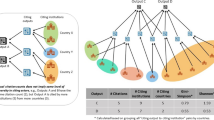Abstract
Using patent citation data for the U.S., we test whether knowledge spillovers in biotechnology are sensitive to distance, and whether that sensitivity has changed over time. Controlling for self-citation by inventor, assignee, and examiner, cohort-based regression analysis shows that physical distance is becoming less important for spillovers with time.
Similar content being viewed by others
References
Almeida P., Kogut B. (1997) The exploration of technological diversity and the geographic localization of innovation. Small Business Economics 9: 21–31
Caballero R. J., Jaffe A. B. (1993) How high are the giants’ shoulders: An empirical assessment of knowledge spillovers and creative destruction in a model of economic growth. In: Blanchard O. J., Fischer S. (eds) NBER macroeconomics annual 1993. MIT Press, Cambridge, MA
Carrincazeaux C., Lung Y., Rallet A. (2001) Proximity and localisation of corporate R & D activities. Research Policy 30(5): 777–789
Dorfman N. S. (1988) Route 128: The development of a regional high technology economy. In: Lampe D. (eds) The Massachusetts miracle: High technology and economic revitalization. MIT Press, Cambridge, MA
Feldman M. P. (1994) The geography of innovation. Kluwer Academic Publishers, Dordrecht, Netherlands
Feldman M. P. (1999) The new economics of innovation, spillovers and agglomeration: A review of empirical studies. Economics of Innovation and New Technology 8: 5–25
Gelsing L. (1992) Innovation and development of industrial networks. In: Lundvall B. (eds) National systems of innovation: Towards a theory of innovation and interactive learning. Pinter Publishers, London
Graham A. (2001) The assessment: Economics of the internet. Oxford Review of Economic Policy 17(2): 145–158
Hall, B. H., Jaffe A. B., & Trajtenberg, M. (2001). The NBER patent citations data file: Lessons, insights and methodological tools. NBER working paper #8498.
Hamermesh D., Oster S. (2002) Tools or toys? The impact of high technology on scholarly productivity?. Economic Inquiry 40(4): 539–555
Henderson J. V. (1986) Efficiency of resource usage and city size. Journal of Urban Economics 19: 47–70
Jaffe A. B., Trajtenberg M., Henderson R. (1993) Geographic localization of knowledge spillovers as evidenced by patent citations. Quarterly Journal of Economics 108: 577–598
Jaffe, A. B., & Trajtenberg, M. (1996). Flows of knowledge from universities and federal labs: Modeling the flow of patent citations over time and across institutional and geographic boundaries. NBER working paper #5712.
Jaffe A. B., Trajtenberg M., Fogarty M. S. (2000) Knowledge spillovers and patent citations: Evidence from a survey of inventors. American Economic Review 90: 215–218
Johnson D. K. N., Brown A. (2004) How the west has won: Regional and industrial inversion in U.S. patent activity. Economic Geography 80(3): 241–260
Johnson, D. K. N., & Popp, D. C. (2003). Forced out of the closet: The impact of the American inventors protection act on the timing of patent disclosure. Rand Journal of Economics, 34(1), 96–112. Previously NBER working paper 8374.
Johnson D. K. N., Santaniello V. (2000) Biotechnology inventions: What can we learn from patents?. In: Santaniello V. (eds) Agriculture and intellectual property rights: Economic, institutional, and implementation issues in biotechnology. CABI Publishing, New York, NY
Johnson D. K. N., Sneed K. A. (2009) Are many heads better than two? Recent changes in international technological collaboration. Journal of Law, Ethics and Intellectual Property 3(1): 1–9
Kim, E. H., Morse, A., & Zingales, L. (2006). Are elite universities losing their competitive edge? CEPR discussion paper 5700.
Lundvall B. A. (1992) User-producer relationships, national systems of innovation and internationalisation. In: Lundvall B. (eds) National systems of innovation: Towards a theory of innovation and interactive learning. Pinter Publishers, London
Maurseth P. B., Verspagen B. (1999) Europe: One or several systems of innovation? An analysis based on patent citations. Economic challenge to Europe: Adapting to innovation-based growth. Edward Elgar Publishing, London
Petersen M. A., Rajan R. G. (2002) Does distance still matter? The information revolution in small business lending. The Journal of Finance 57(6): 2533–2570
Sjoholm F. (1996) International transfer of knowledge: The role of international trade and geographic proximity. Weltwirtschaftliches Archiv 132: 97–115
Smith D., Florida R. (1994) Agglomeration and industry location: An econometric analysis of Japanese-affiliated manufacturing establishments in automotive related industries. Journal of Urban Economics 36: 23–41
Thompson P., Fox-Kean M. (2005) Patent citations and the geography of knowledge spillovers: A reassessment. American Economic Review 95: 450–460
USPTO Technology Assessment and Forecast Program. (1998). Technology profile report: Patent examining technology center groups 1630–1650, Biotechnology. United States Patent and Trademark Office report.
Vasileiadou, E., & Vliegenthart, R. (2009). Research productivity in the era of the internet revisited. http://ssrn.com/abstract=1431457 .
Von Hippel E. (1994) Sticky information and the locus of problem-solving. Management Science 40: 429–439
Winkler, A. E., Levin, S. G., & Stephan, P. E. (2009). The diffusion of IT in higher education: Publishing productivity of academic life scientists. Andrew Young School of Policy Studies research paper series no. 09-01.
Zucker L.G., Darby M.R. (2001) Capturing technological opportunity via Japan’s star scientists: Evidence from Japanese firms’ biotech patents and products. The journal of Technology Transfer, 26(1–2): 37–58
Author information
Authors and Affiliations
Corresponding author
Rights and permissions
About this article
Cite this article
Johnson, D.K.N., Lybecker, K.M. Does Distance Matter Less Now? The Changing Role of Geography in Biotechnology Innovation. Rev Ind Organ 40, 21–35 (2012). https://doi.org/10.1007/s11151-011-9316-6
Published:
Issue Date:
DOI: https://doi.org/10.1007/s11151-011-9316-6




